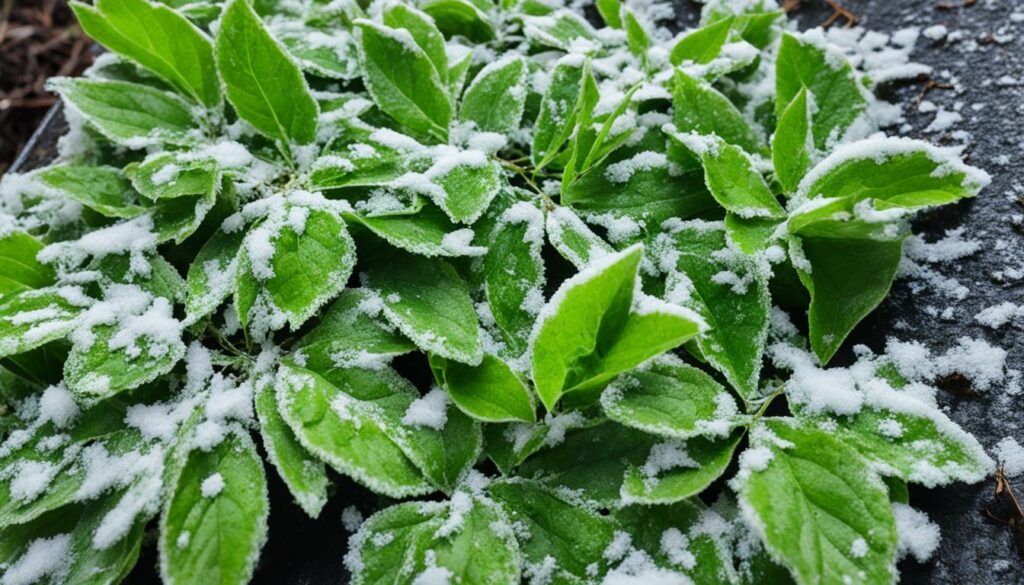To prevent white mold on plants, maintain good air circulation, ensure proper spacing, and avoid overhead watering.
Learn how to shield your plants from white mold with our detailed guide. Gain insights into this prevalent issue, identify initial symptoms, and find out which vegetation often falls victim.
Examine the origins and preventive measures to foster an unwelcoming environment for mold. If faced with an outbreak, discover strategies to control and mitigate its effects, ensuring your garden remains robust and mold-free.
No products found.
Understanding White Mold on Plants

White mold on plants is a common issue that can significantly impact the health and appearance of your garden. It is essential to understand what white mold is and how it affects plants to effectively address and prevent its occurrence.
White mold, also known as Sclerotinia, is a fungal disease that primarily affects plants during periods of high humidity and cool temperatures. This mold forms fluffy, white patches on different parts of the plant, including leaves, stems, and flowers.
Identifying white mold can be crucial in managing its spread. Look for fuzzy white growth that gradually turns gray or brown and feels cotton-like to the touch.
It is important to note that white mold is highly contagious and can spread rapidly to nearby plants through airborne spores or physical contact. Therefore, early detection and prompt action are essential to minimize its impact and prevent further infestations.
Common Plants Affected by White Mold

White mold can affect a variety of plants, but there are certain species that are more susceptible to this fungal infection. By recognizing which plants are commonly affected, you can take proactive measures to protect your garden. Here are some of the plants that are frequently targeted by white mold:
- Roses
- Tomatoes
- Beans
- Peas
- Cucumbers
- Squash
- Lettuce
- Radishes
- Carrots
These plants are often found in vegetable gardens or flower beds, and their lush foliage makes them attractive to white mold. It’s important to closely monitor these plants for any signs of infection and take appropriate action to prevent the spread of white mold.
Causes of White Mold on Plants

White mold on plants can be a frustrating and damaging problem in your garden.
To effectively prevent and address this issue, it is crucial to understand the various causes that contribute to its development. By addressing these root causes, you can proactively protect your plants from white mold infestations.
Here are some common factors that can lead to the growth of white mold on plants:
- Inadequate Air Circulation: Poor air circulation creates a favorable environment for the growth of white mold. This can happen in densely planted areas, in crowded containers, or in areas with limited ventilation.
- High Humidity Levels: White mold thrives in moist conditions. High humidity levels, especially in humid climates or during periods of heavy rainfall, create an ideal breeding ground for the fungus.
- Overwatering: Excessive watering can contribute to the development of white mold. Overwatered plants have prolonged periods of moisture, which encourages the growth of mold spores.
- Planting Susceptible Varieties: Some plant varieties are more susceptible to white mold than others. Certain plants, such as beans, cucumbers, and tomatoes, are particularly prone to white mold infestations.
- Infected Soil or Plant Debris: White mold can persist in the soil or plant debris from previous infestations. Planting in contaminated soil or failing to remove diseased plant material increases the likelihood of new infections.
Prevention Techniques for White Mold

Preventing white mold on your plants is crucial to maintaining a healthy and vibrant garden. By implementing the right techniques, you can create an inhospitable environment for the growth of white mold.
Here are expert tips to help you prevent white mold:
- Adequate Air Circulation: Ensure proper spacing between plants to promote airflow, reducing moisture buildup that favors white mold growth.
- Proper Watering: Water plants at the base, avoiding overhead irrigation that can create a damp environment conducive to white mold.
- Regular Pruning and Trimming: Remove dense foliage and trim overcrowded branches to improve air circulation and sunlight penetration.
- Mulching Techniques: Use organic mulch around plants to regulate soil temperature and moisture levels while preventing fungal spores from splashing onto the foliage.
- Sanitation Practices: Clean garden tools, pots, and any contaminated debris to prevent the spread of white mold.
- Proper Crop Rotation: Rotate susceptible plants annually to minimize the risk of white mold development in the same area.
- Use Resistant Varieties: Choose plant varieties that are resistant to white mold to minimize the chances of infection.
- Fungicidal Treatments: Apply approved fungicides as a preventative measure, especially during high humidity periods or when plants are stressed.
Cultural Practices for White Mold Prevention

To effectively prevent white mold on your plants, implementing specific cultural practices is crucial. By creating conditions that discourage the growth and spread of white mold, you can maintain a healthier garden. Let’s explore some effective practices:
- Proper Plant Spacing: When planting, ensure adequate spacing between plants. This allows for proper air circulation, reducing humidity and limiting the conditions favorable for white mold development.
- Avoid Overhead Watering: Instead of watering from above, opt for methods such as drip irrigation or soaker hoses that deliver water directly to the plant’s roots. Overhead watering can splash soil and moisture onto the foliage, creating a moist environment ideal for white mold growth.
- Regular Pruning and Trimming: Regularly prune and trim your plants to promote good airflow and eliminate crowded areas where moisture can accumulate. Removing infected or dead plant parts promptly can also prevent the spread of white mold.
- Clean Garden Tools: White mold can spread through contaminated garden tools. Clean and sanitize your tools regularly, especially after working with infected plants. This helps prevent the unintentional transfer of white mold spores to healthy plants.
- Proper Plant Nutrition: Maintaining plant health through proper nutrition can strengthen their natural defense mechanisms against white mold. Ensure your plants receive the necessary nutrients and maintain the appropriate soil pH for optimal growth.
- Mulching Techniques: Mulching with organic materials, such as straw or wood chips, can help moderate soil temperature and moisture, preventing excessive dampness that encourages white mold growth. However, avoid over-mulching, as excessive mulch can trap moisture and create a favorable environment for white mold.
Chemical Control for White Mold

When it comes to managing white mold on plants, chemical controls can be an effective tool in your arsenal.
By utilizing the right fungicides and employing proper application methods, you can combat white mold and protect your plants from further damage. Here, we provide you with essential information to make informed decisions regarding chemical control for white mold.
First and foremost, it is crucial to identify the specific fungicides that are effective against white mold. Look for products that contain active ingredients like boscalid, pyraclostrobin, or iprodione as these have shown significant efficacy in combating white mold infections.
These fungicides work by inhibiting the growth and spread of the pathogen, thereby reducing the impact of white mold on your plants.
When applying fungicides, proper timing is essential. Begin the treatment at the first signs of white mold development, such as fluffy white growth on plant surfaces or discoloration of leaves.
Applying fungicides early can help prevent the spread of the disease and limit its severity.
It is important to carefully follow the instructions provided by the manufacturer regarding fungicide application. This includes dilution ratios, spraying techniques, and application frequency.
Adhering to these guidelines ensures maximum effectiveness and minimizes any potential negative effects on your plants or the environment.
Consider implementing a preventative fungicide spray program to protect your plants from white mold before the disease becomes established.
No products found.
Regular application of approved fungicides at specific intervals can create a protective barrier and reduce the risk of white mold infections.
In addition to chemical control, it is crucial to integrate other preventive measures and cultural practices to create a comprehensive approach in managing white mold.
Proper plant spacing, sufficient airflow, and reducing plant moisture can also contribute to preventing white mold infestations.
Managing White Mold Infestations

Although prevention methods are crucial in mitigating the risk of white mold infestations, there are instances where the problem can still arise.
When dealing with white mold, the first step is to identify the affected plants. Look for characteristic signs such as the presence of fuzzy white patches, wilting leaves, and a musty odor.
Once identified, it is essential to isolate these plants from the healthy ones to prevent further spread.
In severe cases, it may be necessary to remove heavily affected plants altogether. This can help eliminate the source of the infestation and protect surrounding vegetation.
Remember to exercise caution when removing the plants, as spores can easily disperse and potentially infect other areas of your garden.
For less severe infestations, it is possible to treat the affected plants and halt the spread of white mold. One effective method is to prune and remove the infected parts using sterilized tools.
Be sure to dispose of the pruned material properly to prevent contamination.
Additionally, applying a fungicide specifically designed for white mold can aid in managing the infestation. Follow the instructions provided by the manufacturer carefully to ensure safe and effective use.
Remember to wear appropriate protective gear, such as gloves and a mask, when handling and applying the fungicide.
While managing white mold infestations, it is crucial to monitor the progress of treatment closely. Regularly inspect the affected plants for any signs of regrowth or new infections.
Promptly address any recurrence to prevent the reestablishment of the infestation.
Providing optimal growing conditions for your plants, such as proper spacing, adequate sunlight, and good airflow, can also help reduce the likelihood of white mold infestations.
These cultural practices create an environment that is less conducive to disease development.
Conclusion and Final Tips

White mold on plants can be a nuisance, but with the right prevention and management techniques, you can keep your garden healthy and vibrant.
To recap, understanding the characteristics and signs of white mold is crucial in addressing the problem effectively. By identifying susceptible plants and addressing the root causes, you can create an environment that is less prone to white mold infestations.
Implementing cultural practices such as proper spacing, adequate ventilation, and regular pruning can go a long way in preventing the growth and spread of white mold.
Additionally, consider using chemical controls such as effective fungicides when necessary, ensuring you follow the recommended application methods.
If you do encounter a white mold infestation, it is essential to act swiftly. Identify and isolate affected plants, and treat them promptly to minimize further damage. Remember to dispose of infected plant material properly to prevent the spread of spores.
FAQ
Q: What is white mold on plants?
A: White mold on plants is a fungal disease that affects various types of plants. It appears as a white, powdery substance on the leaves, stems, and flowers, and can quickly spread, causing damage to the plant’s health and vitality.
Q: How can I identify white mold on plants?
A: White mold on plants is characterized by the presence of a fluffy, white substance on the affected parts of the plant. It may also cause wilting, yellowing, or browning of leaves, and can sometimes produce black specks, known as sclerotia, on the plant’s surface.
Q: Which plants are commonly affected by white mold?
A: White mold can affect a wide range of plants, including vegetables like beans, cucumbers, and lettuce, as well as ornamental plants such as roses, petunias, and geraniums. Certain fruit trees and shrubs, like strawberries and blueberries, are also susceptible to white mold infestations.
Q: What causes white mold on plants?
A: White mold on plants is caused by fungal spores that thrive in cool, humid conditions. Overcrowding, poor air circulation, and excessive moisture in the soil or on the leaves can create the ideal environment for the development and spread of white mold.
Q: How can I prevent white mold on plants?
A: To prevent white mold on plants, it is essential to promote good air circulation by spacing plants appropriately and removing any overcrowded foliage. In addition, avoiding overhead irrigation, providing adequate drainage, and practicing crop rotation can help reduce the risk of white mold infestations.
Q: What cultural practices can aid in white mold prevention?
A: Cultural practices that can help prevent white mold on plants include removing and disposing of infected plant debris, avoiding excessive nitrogen fertilization, and applying a layer of organic mulch to the soil surface. These practices create unfavorable conditions for the growth and spread of white mold.
Q: Are there chemical controls available for white mold?
A: Yes, there are chemical controls available for managing white mold on plants. Effective fungicides, specifically designed to target white mold, can be applied according to the manufacturer’s instructions. It is important to follow safety precautions and use these chemicals judiciously and responsibly.
Q: How can I manage white mold infestations?
A: When prevention methods are not fully successful, managing white mold infestations involves identifying and isolating affected plants to prevent further spread. Pruning infected parts, improving air circulation, and applying appropriate fungicides can help manage the infestation and minimize damage to other plants.
Q: What are some final tips for preventing and managing white mold?
A: In conclusion, it is essential to monitor your plants regularly for early signs of white mold, including the fluffy white growth and wilting leaves. Prompt action, such as removing and disposing of infected plant parts, implementing preventive measures, and seeking professional advice when needed, will contribute to a successful prevention and management strategy for white mold on plants.






